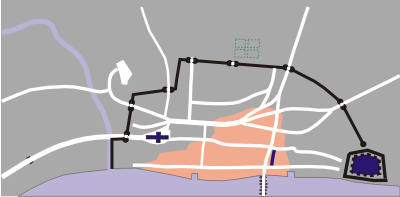Wednesday 5th September – Hope at Last!
Home; and whereas I expected to have seen our house on fire, it being now about seven o’clock, it was not. But to the fyre, and there find greater hopes than I expected; for my confidence of finding our Office on fire was such, that I durst not ask any body how it was with us, till I come and saw it not burned. But going to the fire, I find by the blowing up of houses, and the great helpe given by the workmen out of the Kings yards, sent up by Sir W. Pen, there is a good stop given to it. . Samuel Pepys Diary for 5th September 1666.

- Extent of fire damage on 5th September – same area as on 4th (with thanks to wikipedia for image)
The Wind Drops
On Wednesday the 5th September the strong wind which since Sunday had been blowing the fire west and north finally abated. The army contingents had now created significant fire breaks by virtue of blowing up housing. The effect of these two combined was such that the fire stopped spreading and no significant growth in the area affected by it was reported this day.
Pepys Explores London
According to his diary Pepys walked all over the city, clambering up half burnt out church towers to get a feel for the devastation. He witnessed the teeming throngs of thousands in their encampments around the city such as Moorfields and then returned to the area around his office and his house expecting that they would be inflames but was relieved to see that this was not the case. You can feel his relief in that passage from his diary.
Retribution
That Wednesday night a rumour went about on Moorfields that 30,000 French and Dutch (who the Londoners believed had caused the fire) were on the way to finish the job, and slaughter the population. The mob rose up and attacked anyone suspicious and the King had great difficulty restoring order.
Over at last
The fire smouldered on into Thursday but by midday it was considered completely under control and thoughts turned to trying to determine the cause, assess the damage and plans for rebuilding. It is estimated that the destruction included 13200 houses, 87 churches, 44 Guild Halls, St Pauls Cathedral, Baynard’s Castle, the Royal Exchange, Newgate prison and many other important sites. Maybe 1 person in 3 or 4 of greater London was made homeless. Something like £14 Billion of damages in today’s terms was caused. Although many were made scapegoats, and one poor Frenchman was hung for confessing to starting the fire even though it was clear he was mentally ill and could not have done it, it was eventually put down to the will of God.
Monument

Near the site of the original bakery where the fire had started a monument was constructed. On it read the words:
Here by ye permission of Heaven, Hell broke loose on this protestant city.
A modern version of the monument (near the Underground Station that shares its name) is still there today.
See: Tuesday 4th September – The Fire at full Fury
This article is one of a series connected with the release in August of the new paperback of The Last Seal my historical fantasy set during the Great Fire of 1666.




















